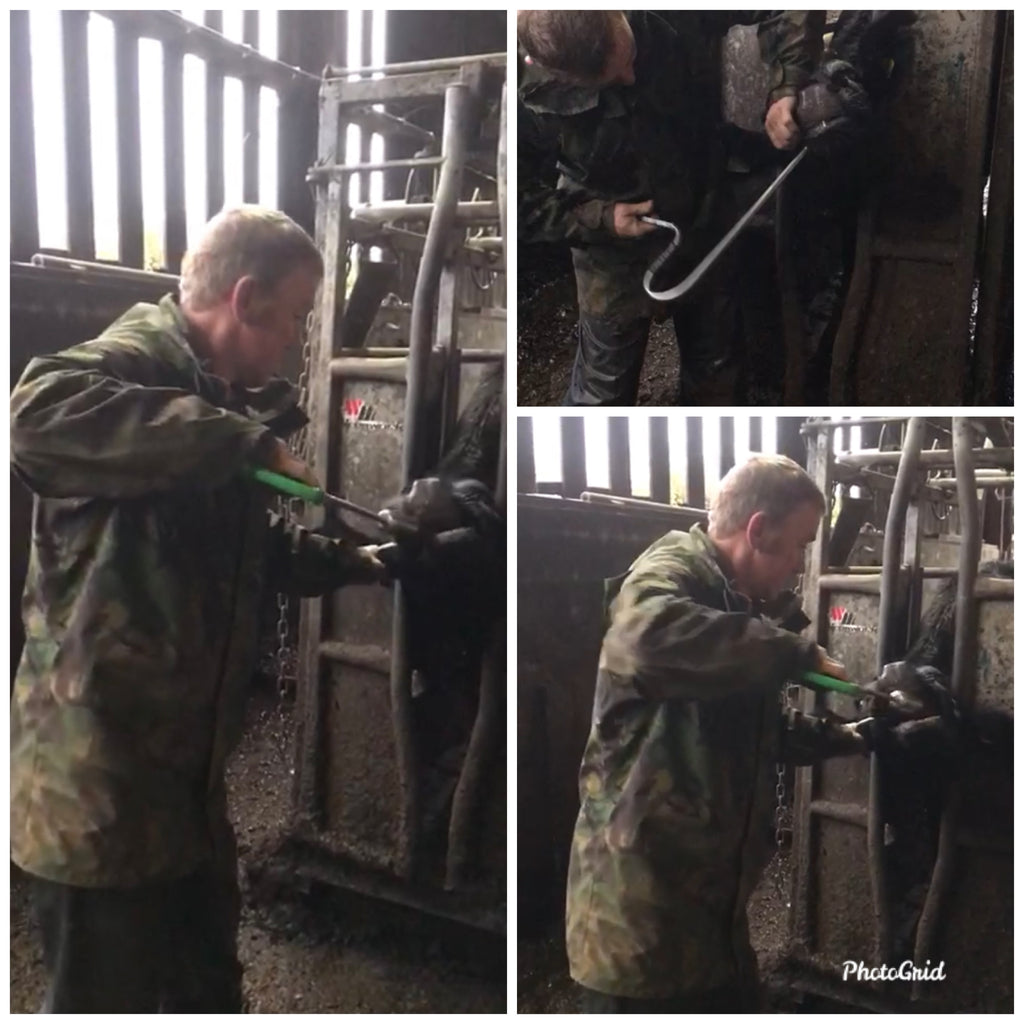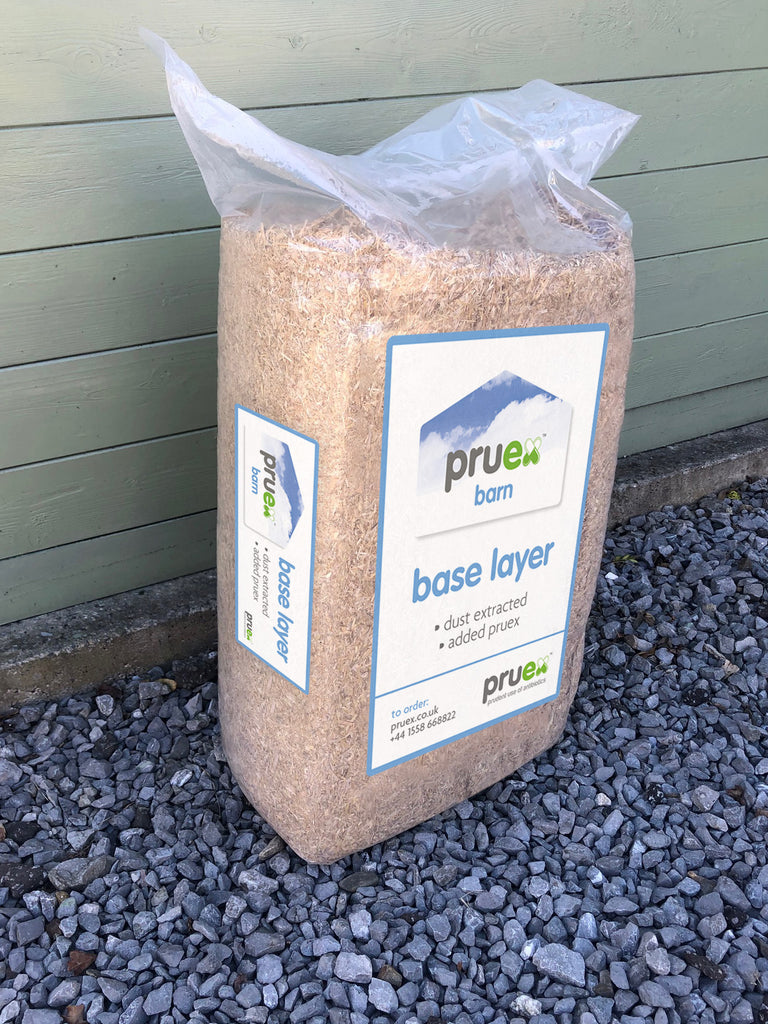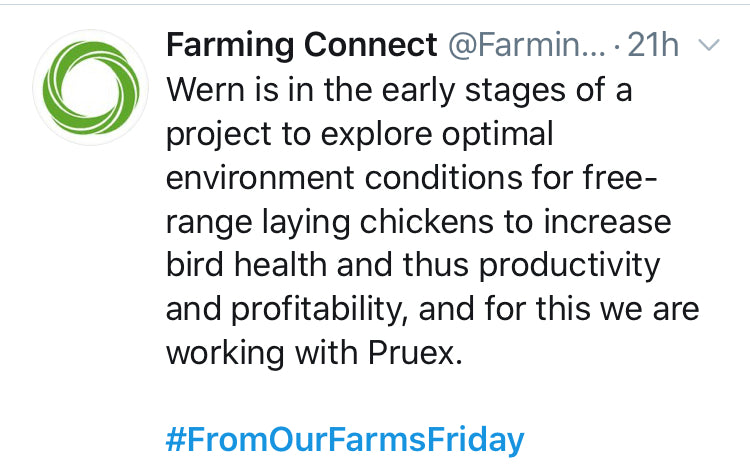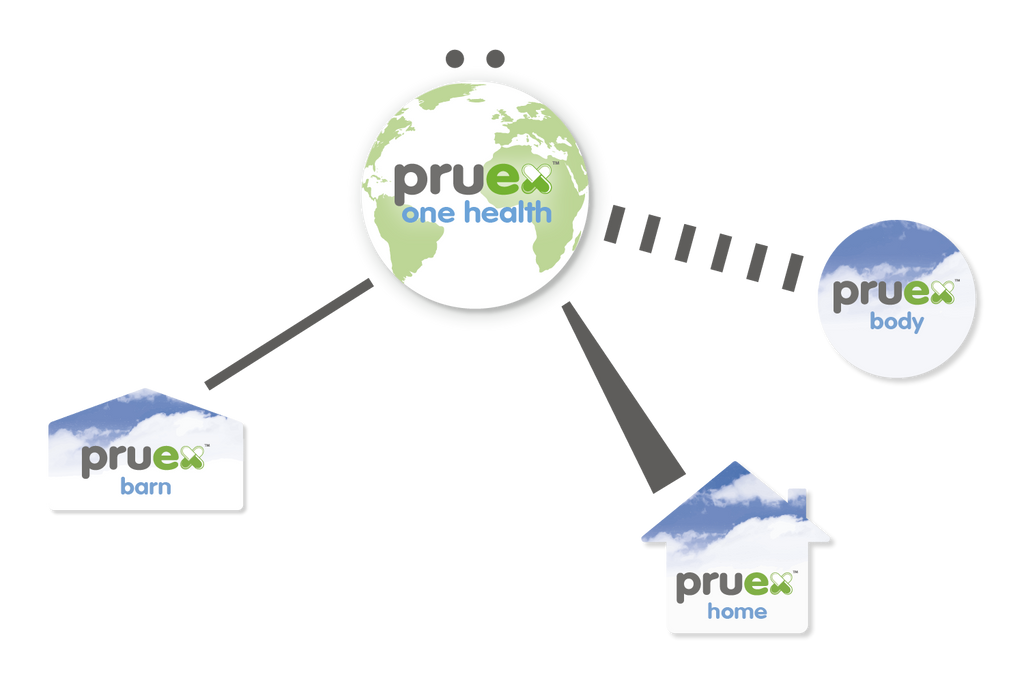News
Pruex 5 point plan. £3000 annual reduction in antibiotic bill.
The Perkins family farm at Dinas Island in West Wales and are one of the main ram producer farms for Innovis, with 500 Abermax stock ewes and a 1,000 strong Lleyn flock with 500 in the Aberfield SR program and 500 put to a Lleyn ram for pure breeding.

The ewes are housed in December for March lambing due to the harsh weather conditions confounded on Dinas Island by a lack of shelter, and are turned out following the recording of ewe and lamb data, such as ease of lambing and birth weights. Prior to implementing the Pruex 5 Point Plan the farm were using lime with straw bedding in an attempt to limit various health issues including joint ill. Pregnant ewes were moved out of their pens weekly and run through an external footbath in an attempt to combat lameness. The worst ewes being targeted and segregated for individual antibiotics treatment. Maintaining clean and dry bedding was a constant battle. Detailed record keeping highlighted the costs of culling heavily according to foot health. Repeat offending ewes with foot problems were culled from the flock increasing the number of ewe lamb replacements needed. Neil noted that prior to using the Pruex products the farm records magnified that foot treatments were the main health burden and were utilising a significant amount of time, resources and money.
Since using Pruex in the lambing shed and in the water supply from December 2018 onwards, the family have stopped using lime as well as foot bathing completely and have seen significant reductions in lameness and lamb infections such as joint ill which used to occur in 2 to 3% of lambs. Pruex Stabiliser is applied as a mist directly onto the bedding in the ewes pens as well as the individual mothering pens daily. Neil has made some rough calculations himself and believes that by drying up the bedding with the mist of Pruex Stabiliser the savings in straw alone equate to the cost of the Pruex products, and that other health benefits such as reduced lameness and lamb infections such as joint ill are a bonus. His antibiotic bill has reduced by £3,000 annually, a major objective of his flock health plan. “The sheep sector is a low net user of antibiotics when compared to other meat sectors, but do use heavily during the lambing period. It’s been the focus of our work for this sector at Pruex, and this type of reduction shows what can be achieved in a small amount of time when farmers have the determination and focus portrayed by the Perkins family”, said Aled Davies,
founder of the company.
Water treatment is done via a dosatron pump with the whole farm receiving treatment 365 days of the year. This incorporates into the rotational grazing program utilised with each water trough readily treated. The water troughs are routinely cleaned before fresh break moves and given an extra 300ml shock treatment of Pruex Water Plus plus as the trough refills.
The detailed record keeping of foot treatments continues and in 2019 the total treatments on the farm have dropped by 68% and the total for 2020 in on track to mirror that improvement. This not only saves time and labour, but it has also reduced the culling rate on the farm due to a reduction in repeat offenders. The farm have also noted a significant reduction in joint ill cases which were
previously treated by catching lambs outdoors, with
problem cases injected with antibiotics. Since the 2019 lambing the number of joint ill cases have reduced greatly with only 3 lambs needing treatment annually.
The plan of action for the 2021 lambing season is to build on the knowledge gained over the last two lambing seasons. In addition to misting the bedding with Pruex Stabiliser and treating the water with Pruex Water Plus, and in order to reduce both workload and toxic bacterial loading on newborn lambs, Pruex Base Layer will be used instead of lime and straw in the mothering pens.
Pruex Base Layer is dust extracted chopped straw (2cm), treated at bagging with Pruex bacteria. It will be used in conjunction with Pruex Stabiliser to absorb moisture and populate good bacteria in the area where lambs need protection during the early stages of their lives.

Using the Easy-Boss-E to reduce stress when bolusing cows.
Cows can get stressed when handled in a crush. If there are several cows that need treatment, the farmers arms and shoulders can get fatigued as well. The Easy-Boss-E is an Oral Distraction tool that takes stress away for farmer and animal.
Once inserted, the cow relaxes to chew its cudd. In the video, the cow is being given a Pruex Post Calving Bolus. This will help her clean post calving. The bolus is quite large, so the farmer inserts the Easy-Boss-E first to calm her, then administers the bolus using a bolus gun. She stops struggling once the Easy-Boss-E is inserted.
Working on a dairy farm to reduce SCC levels
We specialise in solving problems on farm. To do so, we take our time to assess the causes of disease per building or per farm. Once these issues are identified, we assemble bespoke programmes with different packages of tools/products to attack the issues at source. We don't tend to treat symptoms, rather concentrate on the cause. Presentations to farming groups allow us to share what we learn.
FIND - FIX - TELL
Reducing stress at weaning using Quietwean tags from Pruex
A farmers experience of using Quietwean tags.The objective being to reduce stress at weaning. The results, less antibiotic use.
The following video gives some background into the development Quietwean tags.
Bacterial resistance to Disinfectant, Antiseptic and Antibiotics (AMR), is a BIG problem for the population of the globe.
At Pruex, we aim to lead the fight against Antimicrobial Resistance. (AMR). Communicating this problem to people is a challenge, as they don't seem to understand why the issue is called Antimicrobial Resistance, they always ask, why not call it Antibiotic Resistance? They really don't know that bacteria can develop resistance to Antiseptic products and get alarmed when they discover that bacteria can also develop resistance to Disinfectants.
Infection control, a method of cleaning, in hospitals, in homes, in schools, on farms have all concentrated on achieving sterility, but, we and our animals don't live in a sterile world. Minutes after cleaning, the void generated by disinfection is already being repopulated by bacteria and other micro organisms. At Pruex, we communicate a new and highly successful message. Our strategy is to populate the environments we live in with non infective bacteria. That is, good bacteria that doesn't make us or our animals sick. We know how to turn surfaces from being dominated by infectious bacteria into surfaces dominated by harmless bacteria for the long term. This makes the surfaces safe. People and animals then don't need antibiotics because they simply aren't infected by disease causing bacteria.
On farms we measure reductions around 70% in the amount of antibiotics used. On other farms we work to help the farmers achieve zero antibiotic use. We believe strongly that if an animal is infected with a bacteria that can be controlled by antibiotics, that the animal should be treated with the drug for welfare reasons. Prudent (PRU), as opposed to Excessive (EX), use of antibiotics - PRU EX.
Hospitals in countries like Canada, Australia, Germany, Benelux and Italy are already using this technology, and our work in homes and other public places ensure safe environments for those inhabitants.
Pruex work a One Health strategy. We work across all species, human, pet and food producing animals. Work with us, help us inspire others to act.

We saw this video online recently and include it within this document. It communicates the issue we face in terms of Antimicrobial resistance with particular reference to antibiotic resistance. Well done the people at visuallab.no that made the film.
Pruex technology aims to reduce ammonia and the need for antibiotics on a Farming Connect demonstration farm
Pruex are working on a Farming Connect project at Wern Farm near Welshpool in Wales to explore optimal environment conditions for free range laying chickens to increase bird health and thus productivity and profitability.
Farming Connect aim to transform agri-businesses across Wales.
As a government organisation they provide farm and forestry businesses in Wales with support, advice, guidance and training on both a one-to-one and group basis.
Pruex aims to help lead the fight back against Anti-Microbial Resistance (AMR).
Pruex work with:
- Farmers, regardless of species of animal farmed, to develop evidence based strategies on their farms to enable them to develop and demonstrate to consumers their prudent as opposed to excessive use of antibiotics.
- Consumers to enable prudent as opposed to excessive antibiotic use, by limiting the opportunities for infections to take hold and reduce infection pressure.
The video details the scope of the project.
Reducing production costs by improving water quality
There are many farm inputs that dairy farmers can buy which add to the cost of their production. "One of the most expensive things a dairy farmer can do is to give poor quality water to their cows" said Aled Rhys Davies, managing director and founder of Pruex.
Pruex work with farmers to find out which bacterial colonies generate biofilm in their pipes and troughs. Armed with this information, Pruex suggest dose rates of their water product to help prevent biofilm formation.
"We consistently get feedback on milk quality. Positive butterfat and protein modulation as a result of providing clean water. Common sense tells us that you can't get clean milk from dirty water. Our top producers value the extra income they can achieve from getting top quality water" Said Aled.
If you have a horrid slime on the walls of your water troughs, and/or within your water pipes then it would be worth speaking to Pruex. Call today on +441558668822

Nature has the ingredients to help skin
Our quest as humans to achieve almost sterile environments to live in has resulted in us putting great strain on our health. We have cleaned with chemical biocides, and have seen an increase in Fake Food that's highly processed to ensure consumer convenience. The skin and other organs suffer as a result.

Pruex work on all areas needed to take pressure off. We work via Pruex Barn on agriculture, using soil bacteria to ensure a dry bed, clean air and water for livestock, and our agricultural arm of Pruex Body to work on the inside of the animals using plant material. Healthy animals are needed to form a healthy balanced diet. Pruex Home is where we use soil bacteria to ensure healthy environments for humans and pets, and we have Pruex Body products, plant material to help on the inside of the body.
In this example, Acne caused the young girl pictured to loose confidence. Having identified the likely cause in her environment and diet, we recommended changes she could make to her lifestyle using Pruex Home and Body products.

We're delighted that she feels confident enough for us to publish her photos, and wish her well for her future.
Will our skin save us from Covid-19?

Synbiotic skin care
In humans, the skin is considered to be the largest organ and, like the internal organs, contains several layers of specialised cells (tissues) that function together. The condition of the skin sometimes provides important information about whether or not the body as a whole functions properly. Our skin is the first and most important barrier to the outside world and protects us against harmful influences and infections.
Moreover, it has become clear in recent years that the skin carries a large number of micro-organisms (= skin microbiome or skin flora) that fulfil an important function. When the skin flora or the skin are disturbed, this can lead to a large number of (serious) problems.

The skin and its microbiome
Human skin has an area of 2 square meters and consists of 3 main layers: the epidermis, dermis and hypodermis; each of which still consists of several sublayers with a specific function. Each square cm of the skin contains about 100 sweat glands, 10,000 cells and 200 nerve endings in addition to blood vessels!
The skin has several important functions:
-
Protection against harmful germs and the outside world
- Measure via the nerve endings of e.g. outside temperature
- Temperature control via intensive blood flow
- Moisture regulation via the sweat glands
- Storage of fats, vitamin D and other vital substances
- Absorption of oxygen or, for example, medicines via ointments or patches
- Social function in which the colour and health of the skin play a role in human interaction
In addition to the skin (structure) itself, recent research also shows that the microflora present on the skin (= skin microbiome) plays a very important role. A microbiome is the total number of micro-organisms (mainly bacteria) that are located somewhere; whether they work together as a community or not. The best known microbiome is that of humans and includes, for example, the micro-organisms present in our mouth, digestive system and on our skin. Even though these microorganisms do not all work together, they do determine the "state (or health)" of the place where they are located. A stable, healthy microbiome is therefore of great importance for our health and that of the entire environment. Human skin naturally contains millions of micro-organisms!
Skin disorders
The skin structure and its microbiome are both important to protect us from many harmful influences and infections. When one or both are damaged, there is a good chance that we will have skin or health problems. Very often these problems are directly or indirectly linked to microbiology. When the skin is physically damaged, certain microorganisms can suddenly cause infection, while not doing so on intact skin.

Some of the most common skin disorders:
- Acne: inflammation of the sebaceous glands with possible secondary infections of the wounds
- Allergy: reaction of the skin to all kinds of external or internal substances
- Atopic eczema: chronic inflammation of the skin causing damage
- Dermatitis: acute skin infections with different causes
- Dry skin: damage to the skin due to an incorrect water balance
- Shingles: inflammation of the skin due to the Varicella virus
- Psoriasis: disordered skin renewal process with unpleasant symptoms
- Fungal infections: inflammation of the skin due to infection with Candida or other fungi
- Staphylococcus infections: serious infections and inflammations with the Staphylococcus bacteria
- Warts: skin damage from viral infections
It is also possible that an underlying condition (e.g. cancer) has a negative effect on the skin, causing it to be damaged and thus causing additional problems.
In the prevention and cure of most skin conditions, it is crucial to keep the skin structure and the skin microbiome in good condition!
Classic soaps and disinfectants
Until a few years ago, people were not yet aware of the great importance of the skin microbiome. The soaps, shower gels, shampoos that had been developed until then mainly aimed at cleaning the skin as powerfull as possible, often with very strong degreasing effect. On the one hand, such degreasing damages the skin itself, but especially also the natural microflora that is on the skin. This greatly disrupts the skin and its microbiome, causing them to lose their protective function.
Disinfectants are absolutely harmful to the skin and its microbiome. These products date from the era of aseptics in which they wanted to kill all micro-organisms in order to obtain good hygiene. In the meantime, science has shown that a large number of micro-organisms exist that are useful or even necessary for our good health. Disinfectants also kill these good microorganisms and also create resistance among the bad germs.
Classic chemical soaps and certainly disinfectants damage the skin and the microbiome, increasing the risk of skin problems!
Synbio® skin cleansing and care
After many years of research, Chrisal has developed a technology for skin cleansing and care that maximally respects the skin and its microbiome and keeps it in good condition! This patented (EP3210612A1) technology is based on synbiotics:
Synbiotics: Probiotics: Prebiotics:
the combination of probiotics and prebiotics.
good bacteria that improve human and animal health nutrients that stimulate the development of good bacteria
Image of Prebiotics
Image of Probiotics
The Synbio® skin care products contain a high concentration of probiotics and prebiotics. The probiotics reduce the risk of infections and install a good protective microbiome on the skin. The prebiotics support and stimulate the growth and activity of naturally good skin bacteria. In addition, the probiotics are active dirt removers that clean the skin on a microscopic level. This leads to a permanent skin cleansing and therefore a smooth and healthy skin.
The main goal is to prevent an unhealthy skin microbiome. Because the Synbio® products actively add high numbers of good bacteria (the probiotics) and stimulate the growth of existing good skin bacteria through the prebiotics, a very stable and healthy microflora is formed and maintained.
This stable healthy skin microbiome provides many benefits, both preventive and curative. Academic research institutes have conducted extensive research into the effects of this technology, which makes the claims made clinically proven!
BAD MICROFLORA WITH CLASSIC SOAPS AND DISINFECTANTS
GOOD MICROFLORA WITH SYNBIO® SKIN CLEANSING AND CARE PRODUCT

For more information, please call us on +441558668822
Pruex - One Health
There are many types of bacteria present on planet earth. Of the ones we know about, the majority are harmless, some beneficial to health, but others exist that can cause disease in animals including us humans. Since the 1950’s, our medical and veterinary professionals have used antibiotic, biocidal (disinfectant), and antiseptic products to control these harmful types. But, these disease causing bacteria are developing resistance to these products. This is known as antimicrobial resistance (AMR), and is a major cause for concern globally. Disease pandemics are known to damage social and economic infrastructure. A viral pandemic could weaken peoples’ immune systems to a point that the patient has no defence against virulent pathogenic bacteria that can’t be controlled by biocides in our hospitals, and that can no longer be controlled within the patient by treatment with antibiotics, due to AMR. Pruex aims to inspire change in our strategy and lead the fight against AMR using what nature has taught us.

In nature, there is a balance of bacterial types, regulated by the way each colony jostles and competes for dominance. There is never a void, there is always bacteria. Humans and animals don’t live in sterile environments. The balance is maintained as healthy when there are more harmless bacteria than there are harmful types. If all types are removed, via heat, or chemical action, for example by disinfection, then a race to repopulate the void ensues. If the race is won by the harmful bacteria, then the risk of animals contracting disease increases. Soil is dominated by harmless bacteria, whereas faeces is dominated by harmful types. In nature, animals are surrounded by soil, and as long as they don’t contaminate their water, bedding or air with faecal bacteria, their risk of contracting bacterial disease is limited.
Pruex apply a one health approach to reduce the threat of AMR globally, working to help professionals in human and animal health sectors do all they can to ensure the good types of bacteria win.

Human misuse of antibiotics and disinfectant is driving the threat of AMR, but press coverage seems to point the blame at veterinary use in agriculture. To succeed in our aim of reducing the risk of AMR, humans can’t divide opinion and concentrate blame on one section of our social and economic infrastructure over another. We have to work as a team and target all areas of concern collectively. A one health approach.

In hospitals, “super bugs” are very problematic. People with no infections catching bacterial disease whilst in hospital. The infections caused by bacteria that are either resistant to disinfection, or that can survive disinfection by being protected in a biofilm, a nest of slime that disinfection can’t totally eradicate from surfaces. From their nest of slime, they quickly win the race to repopulate the void generated by the cleaning process. Biofilm also pose a health problem in our homes, offices, recreational establishments and schools. If soil isn’t dominant, good types of bacteria are not dominant, and a biofilm exists. The infective types of bacteria win the race over the good types. Pruex provide good bacteria in cleaning products that remove biofilm without creating a void and reduce the risk of infective bacteria making people sick. If they’re not infected, they don’t need antibiotics. This reduces the risk of infective bacteria becoming resistant to disinfection and antibiotics.

The immune system has a role to play, for humans and animals alike. Age, stress levels, genetics, diet, exercise, air quality, temperature, humidity, water quality, mental health and wellbeing are all variables that can influence the effectiveness of the immune system in defending people and animals against infections. The role of colostrum in mammals or yolk in birds in ensuring passive immunity from mother to offspring can also determine the strength of the immune system. Pruex apply a two fold strategy to disease prevention, using non infective bacteria to ensure less risk of environmental infections, and dietary products to work with the immune system from within. Protecting from outside and inside the body.

Bacterial infections in our food production systems are problematic, reducing efficiencies, and adding costs to production. Sick animals don’t grow well. Post the second world war, the need for low cost food saw an intensification of agriculture to prevent starvation of human populations. As a result, animals have been kept in large numbers. So water systems have been developed to pipe water to animals. Biofilm is a major problem within these water systems. The tools used by veterinarians to limit the effect of infections have been antibiotics, disinfectants and antiseptics, but the threat of AMR requires a new strategy. Pruex provide dietary products to work from within the animals’ body and good bacteria in cleaning products for surfaces and water systems to remove biofilm without creating a void. This strategy reduces the risk of infective bacteria in the animals’ water and bedding infecting animals and generates lower levels of ammonia and carbon dioxide. Farmers and pet owners alike work with Pruex to ensure a dry bed, clean air and water for their animals, reducing the risk of infection. If the animals aren’t infected, they don’t need antibiotics. This reduces the risk of infective bacteria becoming resistant to disinfection and antibiotics. Consumers can be confident that animals reared in a Pruex barn are healthier.
Pruex aims to lead the global fight against AMR. Please work with us.









